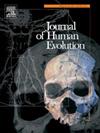Reconstruction of the locomotor repertoire of early primates in the light of astragalar and calcaneal shape
IF 3.1
1区 地球科学
Q1 ANTHROPOLOGY
引用次数: 0
Abstract
The locomotor behavior of the earliest euprimates is key to our understanding of the origin and early diversification of the group. Postcranial traits suggest that major locomotor shifts occurred during the early evolution of this clade. Two tarsal bones, the astragalus and the calcaneus, have been extensively studied because of their functional importance. To provide further insights into early primate evolution, we use a three-dimensional high-density sliding semilandmark geometric morphometric approach to quantify tarsal shape on an extensive (936) sample of astragali and calcanei from extant and extinct primates as well as other euarchontans. We reconstruct the locomotor repertoire for a total of 37 extinct taxa, representing all major Paleogene primate groups, using a partial least squares regression between astragalar/calcaneal shape and locomotor percentages compiled from the literature. Our results concur with previous studies and confirm that the astragalar/calcaneal shape exhibits a strong functional signal, allowing to accurately estimate the locomotor repertoire of extinct species. Locomotor estimates based on fossils indicate that early euprimates displayed a diverse array of locomotor repertoires comparable to extant species, highlighting cases of convergent evolution among distantly related groups. Locomotor differences between plesiadapiforms and early euprimates include a greater use of leaping by the latter, suggesting that the origin and early diversification of euprimates involved an important locomotor shift. Based on tarsal shape, this study improves our understanding of early primate locomotion and evolution, providing the most extensive taxonomic scope to date.
从黄骨和跟骨的形状重建早期灵长类动物的运动能力
最早的真灵长类动物的运动行为是我们理解这个群体的起源和早期多样化的关键。颅后特征表明,主要的运动转移发生在这支进化的早期。两种跗骨,黄芪和跟骨,由于其重要的功能而被广泛研究。为了进一步了解早期灵长类动物的进化,我们使用三维高密度滑动半标记几何形态计量学方法,对来自现存和已灭绝灵长类动物以及其他原始动物的大量(936)黄芪和跟骨的跗骨形状进行了量化。我们利用文献中收集到的黄芪/跟骨形状与运动百分比之间的偏最小二乘回归,重建了37个已灭绝类群的运动功能库,这些类群代表了所有主要的古近系灵长类类群。我们的研究结果与之前的研究一致,并证实了黄芪/跟骨的形状显示出强烈的功能信号,可以准确地估计灭绝物种的运动能力。基于化石的运动估计表明,早期的真灵长类动物表现出与现存物种相当的多种运动技能,突出了远亲群体之间趋同进化的案例。蛇适应型动物和早期原始灵长类动物之间的运动差异包括后者更多地使用跳跃,这表明原始灵长类动物的起源和早期多样化涉及一个重要的运动转变。基于跗骨的形状,这项研究提高了我们对早期灵长类动物运动和进化的理解,提供了迄今为止最广泛的分类范围。
本文章由计算机程序翻译,如有差异,请以英文原文为准。
求助全文
约1分钟内获得全文
求助全文
来源期刊

Journal of Human Evolution
生物-进化生物学
CiteScore
6.30
自引率
15.60%
发文量
104
审稿时长
3 months
期刊介绍:
The Journal of Human Evolution concentrates on publishing the highest quality papers covering all aspects of human evolution. The central focus is aimed jointly at paleoanthropological work, covering human and primate fossils, and at comparative studies of living species, including both morphological and molecular evidence. These include descriptions of new discoveries, interpretative analyses of new and previously described material, and assessments of the phylogeny and paleobiology of primate species. Submissions should address issues and questions of broad interest in paleoanthropology.
 求助内容:
求助内容: 应助结果提醒方式:
应助结果提醒方式:


